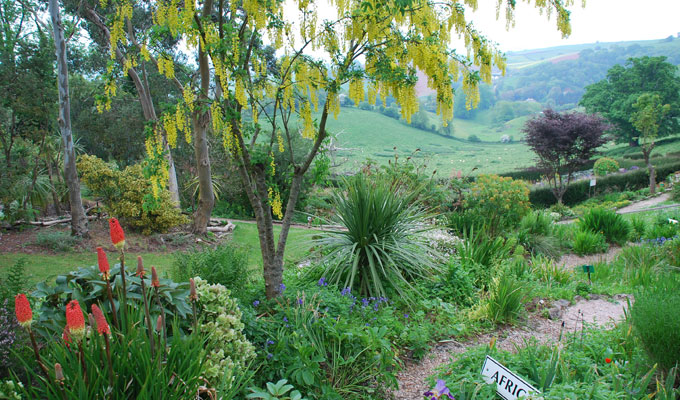The Gardens...
In 1986, one of the floral delights of Devon, Plant World Gardens, was the first garden
ever to be laid out to represent each of the five continents of the world,
although several copies now exist around the world. These inspirational gardens
contain countless rare and exotic plants seldom seen outside their native lands.
Read on to learn more about each of our specially planted gardens.
The African Garden...
Although the north side of a hill top may not be the ideal situation to grow African plants
, many of those from higher, colder and damper elevations on the African continent do well here.
Species that do especially well are dieramas or “Angels’ Fishing Rods”, and possibly the best
collections in the UK of these lovely specimens, species and cultivars, is grown here.
Agapanthus or “African Lilies” are also well-represented here, including some dwarf and
differently-coloured forms. Other attractive members of the iris family such as crocosmias
and moraeas also do well here, now forming congested beds on the steep slopes.
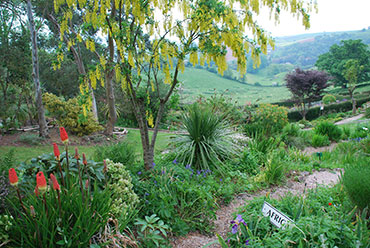
The African Garden
The American Garden...
North America has a wide diversity of habitats from desert to arctic, so special environments had to be designed and built.
Fragrant erythroniums or “Dog’s Tooth Violets” smother the ground in April,
soon followed by the dazzling displays of penstemons and mountain columbines.
Many of our cultivated conifers originate from the USA and a large mature
collection of these is also in evidence providing welcome shelter from the
north winds in winter.
South American plants are mainly confined to those from Chile and Argentina. Ray organised a seed collecting expedition to Central and Southern Chile in 1994. (See History section.) Many of the plants now growing were produced from seeds he brought back. These include alstroemerias, puyas and fascicularias which are both hardy members of the pineapple family, fuchsias, and “Monkey Puzzle Trees” (or araucarias.) The strong, overpowering curry smell from the Escallonia viscosa tree baffles all visitors, as it is only evident if you stand downwind, and not at all when you touch it!
South American plants are mainly confined to those from Chile and Argentina. Ray organised a seed collecting expedition to Central and Southern Chile in 1994. (See History section.) Many of the plants now growing were produced from seeds he brought back. These include alstroemerias, puyas and fascicularias which are both hardy members of the pineapple family, fuchsias, and “Monkey Puzzle Trees” (or araucarias.) The strong, overpowering curry smell from the Escallonia viscosa tree baffles all visitors, as it is only evident if you stand downwind, and not at all when you touch it!
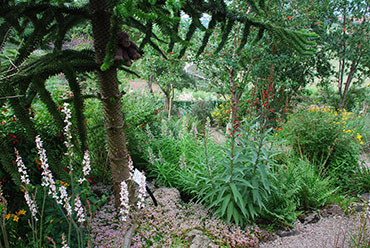
The American Garden
The New Zealand Garden...
New Zealand visitors to this area of the garden have said that it really is just like being back home.
Tall pittosporums and cordylines, or “Cabbage Palms”,
tower above some remarkable and unusual flowers such as
the giant “Forget-me-nots” (or myosotidiums.) A large
tree fern (Dicksonia Antarctica) still thrives here in
spite of weathering more than twenty degrees of frost.
Intriguingly, many of the New Zealand native plants have white flowers. The prevalence of white flowers seems to be related to New Zealand’s lack of specialised insect pollinators. Flower colour attracts certain pollinators – for example, long-tongued bees, which respond especially to blue and ultraviolet. New Zealand has no native species of long-tongued bees, the chief pollinators being flies, moths and short-tongued bees. So therefore, producing colour pigments is at considerable cost to the plant in terms of resources and genetic coding, and if colour has no advantage, evolution tends to select against it.
Intriguingly, many of the New Zealand native plants have white flowers. The prevalence of white flowers seems to be related to New Zealand’s lack of specialised insect pollinators. Flower colour attracts certain pollinators – for example, long-tongued bees, which respond especially to blue and ultraviolet. New Zealand has no native species of long-tongued bees, the chief pollinators being flies, moths and short-tongued bees. So therefore, producing colour pigments is at considerable cost to the plant in terms of resources and genetic coding, and if colour has no advantage, evolution tends to select against it.
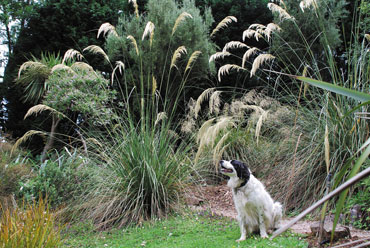
The New Zealand Garden
The Australian Garden...
Visitors simply cannot believe that the enormous 80 foot high eucalyptus trees,
with massive trunks, were planted here as seedlings in 1986.
Under the shade of these live some of the rarest high alpine shrubs and plants
from the Australian mountains. Some of these, such as the banksias,
hakias and grevilleas are members of the strictly southern-hemisphere
Protea family, and have thrived here, even through the arctic winters of
2009 and 2010. Also here are surprises for the children. Katy Koala hides
in her little house, ready for children to press the button so that she
can squirt water at unsuspecting parents.
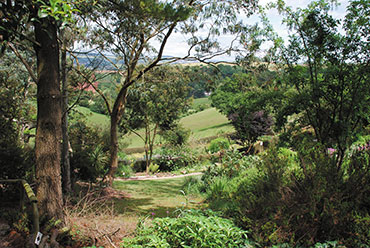
The Australian Garden
The European Garden...
The first garden you encounter after leaving the mature cottage garden is “Europe”.
Tall tree heathers from the Mediterranean regions tower above the pathways with
bright sprays of pink or white flowers. Spring bulbs appear in February and
March soon followed by globe thistles and the giant Gentiana lutea, with
stunning sprays of bright yellow, starry flowers.
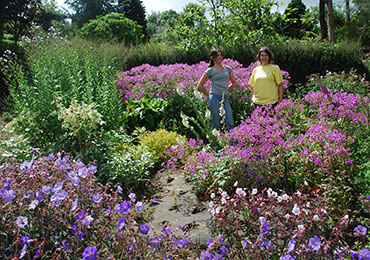
The European Garden
The Himalayan Garden...
One of the garden’s gems, the Himalayan area is home to some of the plants most coveted by gardeners.
These include beds of the fabulous Himalayan blue poppy, Meconopsis baileyii,
as well as varieties of even rarer Mountain meconopsis which appear in a wide
spectrum of colours from white to crimson. The small ponds are home to an
enormous number of amphibians, frogs, toads and newts, which gather here to
spawn en masse every February or March. Also in evidence are many varieties
of Asiatic primulas, some of them rising to an unbelievable 3 feet high
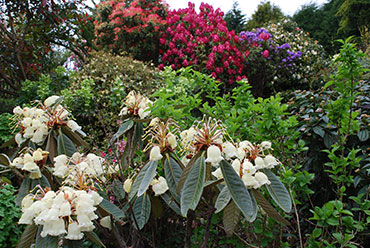
The Himalayan Garden
The Siberian Garden...
The northern part of the Asiatic garden is dedicated to plants from the colder regions of the world including Russia and China.
Ray led a month-long seed-collecting expedition from Plant World to Eastern Russia in the summer
of 2002. This focussed on the almost un-botanised island Of Sakhalin, a large, north-south
orientated island north of Japan, in the cold Sea of Okhotsk. Although this island, comparable
in size to the whole of Great Britain, is on the same latitude as the UK, it suffers arctic
winters with temperatures plummeting to minus 40 Centigrade. Indeed the sea freezes over
for 3 months enabling locals to drive out and fish through the sea ice. Many of the plants
grown from seed that were brought back now thrive in the relatively tropical climate we have here.
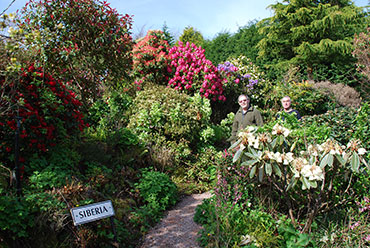
The Siberian Garden
The Cottage Garden...
In this garden grow all of the plants that do not fit into the concept of “flowers from around the world”!
In February a large display of the rarely encountered broad-leafed snowdrop,
Galanthus elwesii, borders a pathway, soon to be followed by impressive displays
of Helleborus orientalis or “Lenten Roses”. Later, old-fashioned michaelmas
daisies vie with giant thistles and lupins amidst mature specimens of unusual shrubs.
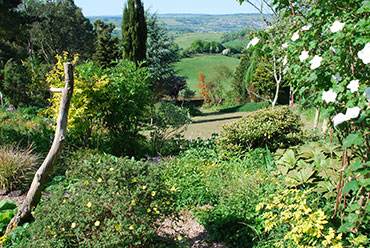
The Cottage Garden
The Mediterranean Garden...
Constructed in memory of Muriel Brown, Ray’s mother, this area in the warmest part of the garden is
home to plants that thrive in hot conditions.
Even though Plant World is on the south coast of Devon, its north-facing hilltop aspect provides
very few sheltered areas, but this warm, well-drained spot is home to a large variety of sun-lovers,
from lavenders and verbascums to large specimens of cistus or “Rock Roses”.
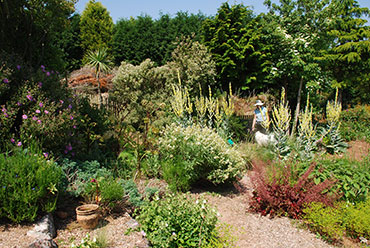
The Mediterranean Garden
The Hot Garden...
Right at the top of the hill in prime position is the small hot garden.
This area was originally planted with all manner of exotic and
succulent plants in 2000. However, the outrageously-cold winters
of 2009 and 2010 soon put paid to the high hopes of the ever-hopeful gardeners,
and this area is now mainly populated by a truly impressive display of
hundreds of hollyhocks in every possible colour. Unintentional but
still beautiful!
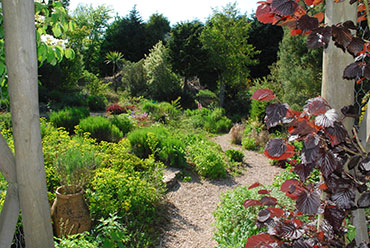
The Hot Garden
